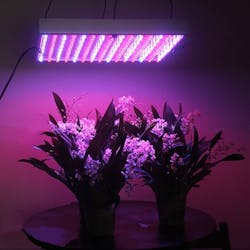ASABE publishes a metric standard for LED-based horticultural lighting
The American Society of Agricultural and Biological Engineers has published the first in a series of three planned standards focused on horticultural SSL, with the first focused on definitions and descriptions of metrics.
The American Society of Agricultural and Biological Engineers (ASABE) has announced publication of the ANSI/ASABE S640 standard entitled “Quantities and Units of Electromagnetic Radiation for Plants (Photosynthetic Organisms).” The work is the first in an expected three-prong effort of standards development by ASABE that can forward the proliferation of LED-based horticultural lighting. Solid-state lighting (SSL) is increasingly important to horticulture in both vertical farms and as supplemental under-cover applications in greenhouses, and the standards effort is intended to provide a common language for characterizing LED-based systems relative to plants.
Interested in articles & announcements on horticultural lighting?
A revolution is happening in horticulture. It’s a seismic shift that will change fundamentally how we grow plants — and it’s all down to lighting. The next Horticultural Lighting Conference will take place in Denver, CO on Tuesday, October 17, 2017. To find out more information and to register to attend please click here.
The standards effort for characterizing LED-based lighting for humans has been underway for a decade or more now. But basic metrics such as efficacy (lm/W) that are directly applicable to humans, since the lumen is based on human visual sensitivity, have little applicability to the effectiveness of light for plant growth. That issue is one we have covered in a number of articles including a feature last September.
Last November, we published a detailed article about the work of the ASABE that had begun back in 2015 and that by last year had become a three-part proactive effort on standards development. As our article described, the first priority was definition of metrics and a new plant biologically active radiation (PBAR) radiometric band that spans 280–800 nm — covering the ultraviolet (UV) region below human visual sensitivity and the far-red region above.
The horticultural sector has for some time used de facto metrics such as photosynthetic photon flux (PPF) and photosynthetic photon flux density (PPFD) that are based on the photosynthetically active radiation (PAR) band from 400–700 nm. Those metrics remain useful. But UV light is now known to impact plant morphology. And the far-red region can impact seed germination, flower induction, plant height, and leaf expansion. The new standard will add new metrics in those regions.
The ASABE announcement said the S640 standard would be available for purchase in six weeks. But the standard appears to already exist in the ASABE Technical Library. Visit that library (http://elibrary.asabe.org/) and search for S640 and an offer to purchase the standard will be displayed. The non-member price is $61.
The new standard, as well as the continued development of the next two standards in the pipeline, will certainly be detailed at our upcoming Horticultural Lighting Conference. Make plans to join us Oct. 17 in Denver, CO.

Maury Wright | Editor in Chief
Maury Wright is an electronics engineer turned technology journalist, who has focused specifically on the LED & Lighting industry for the past decade. Wright first wrote for LEDs Magazine as a contractor in 2010, and took over as Editor-in-Chief in 2012. He has broad experience in technology areas ranging from microprocessors to digital media to wireless networks that he gained over 30 years in the trade press. Wright has experience running global editorial operations, such as during his tenure as worldwide editorial director of EDN Magazine, and has been instrumental in launching publication websites going back to the earliest days of the Internet. Wright has won numerous industry awards, including multiple ASBPE national awards for B2B journalism excellence, and has received finalist recognition for LEDs Magazine in the FOLIO Eddie Awards. He received a BS in electrical engineering from Auburn University.





![The DesignLights Consortium continues to make progress in shifting outdoor lighting products and implementation practices toward a more restrained and thoughtful strategy. [Image does not represent a DLC qualified fixture.] The DesignLights Consortium continues to make progress in shifting outdoor lighting products and implementation practices toward a more restrained and thoughtful strategy. [Image does not represent a DLC qualified fixture.]](https://img.ledsmagazine.com/files/base/ebm/leds/image/2024/08/66be810888ae93f656446f61-dreamstime_m_265700653.png?auto=format,compress&fit=&q=45&h=139&height=139&w=250&width=250)